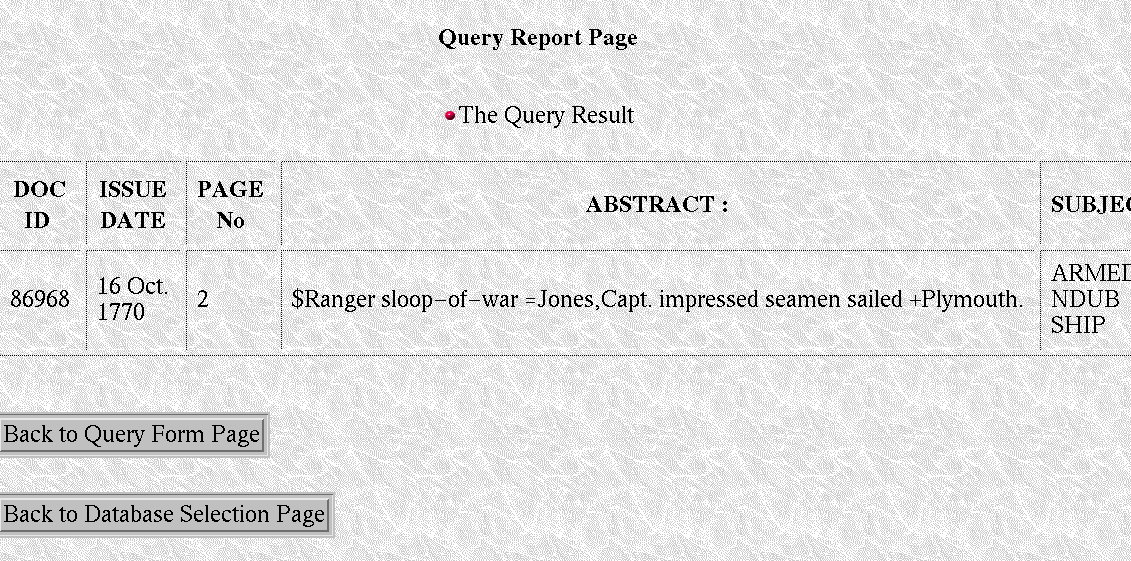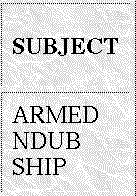
The Query Report that you see after submitting your search (with or without wildcard) provides the information you need to find the original news item or advertisement as it appears in either the microfilm or originals of The Belfast Newsletter.


Column 2: ISSUE DATE indicates the date of issue of the newspaper in which the item appears. You will need this to find the original item in the microfilm of The Belfast Newsletter.

Column 3: PAGE NO. the page number of The Belfast Newsletter on which the item may be found. See Warnings.



After retrieving the documents to any Query Result Report, you may print the Report as it appears on the screen by clicking the Print icon on your browser's Navigation toolbar, or you can download the results to your own computer by clicking on File, then Save As (procedure may vary depending on the web browser used).
Once you have identified the issue date and page number you can see the item in its original entirety by going to the original newspaper (or, more frequently, a microfilm version).
Users should be careful not to assume that the quasi-abstract is the literal wording of the original. In this index "insignificant" words, such as connectives, conjunctions, prepositions, were usually not included. Words that appeared more than once in the same item were only indexed one time.
Identically-worded advertisements that appeared more than once in the same or subsequent newspapers were indexed only the first time they appeared.
Please note that it is NOT necessary to use the symbols and slashes that you see in the ABSTRACT column when making searches. The following information is provided only to help you to understand the ABSTRACT column of a Query Report.
What follows is the Query Result for ABSTRACT:

There are three symbols used in the ABSTRACT column:
One of these symbols is placed immediately in front of a word to indicate that the word designates a person, a place or a ship and to differentiate it from other words with which it might otherwise be confused. For example, if you saw the word "Antrim" you would have no way of knowing if the reference was to the person (the Earl of Antrim), the place, or the ship of that name. But it becomes immediately clear when the word is written so: $Antrim.
In the ABSTRACT column the spaces between words of a multi-worded name (whether it be a personal, place, or ship name) are filled in with slashes or exclamation marks. These may be ignored by the user.
For example, the ship Charming Nancy becomes: $Charming/Nancy The person Mr. John Jones becomes: =Jones,John/Mr. The place High Street becomes: +High!St. Note also that while slashes / are used in personal and ship names, the exclamation mark is used in place names
REPEAT: It is NOT necessary to use these symbols when making searches.
With very few exceptions, the text of the original Belfast Newsletter was transcribed into the database exactly as it appears in the original. The user should be aware that spellings during the 18th century were not as fixed as they are today; consequently, common words may be spelled in a variety of ways. For example, today's "jail" may be spelled "gaol" or even "goal" in The Belfast Newsletter. The city of Coleraine is spelled over a dozen different ways.
Therefore, the user will often benefit from performing a wildcard search for words with many potential variants. This is done by placing an asterick (*) within or at the end of a string of letters. For example, to find the variant spelling of Coleraine one might submit the wildcard search "Col*" in the Place Name box. This will retrieve all places in the database beginning with the string "Col".
A few words have been silently abbreviated, but only when they are used in association with other words. For example, street becomes St. in +High!St.; road becomes Rd. in +Dublin!Rd.; General becomes Gen. in =Washington,Gen.; Lieutenant becomes Lt., etc.
All European personal names and titles are formatted by placing the surname first followed by the other names and/or titles. The symbol for a personal name is the =. Non-European names, such as Suliman Bey Oglou, are not treated in this way. They are left as they appear in the text and without the = sign. Therefore, to search for a non-European name one must search in the KEYWORD category and not in the PERSON NAME category.
Examples:
Place names designate a geographical place, but not buildings, such as castles, palaces, etc. Therefore Dublin Castle is not treated as a place although Dublin is. All place names are preceded by + in the abstract. Examples: +High!St. +New!England
The names of Irish counties have been treated somewhat differently. In all cases the county name is abbreviated to "Co." Thus, County Down becomes Co. +Down.